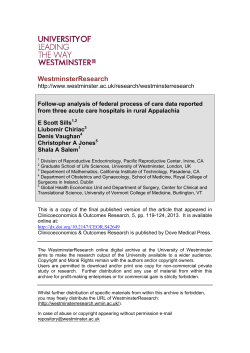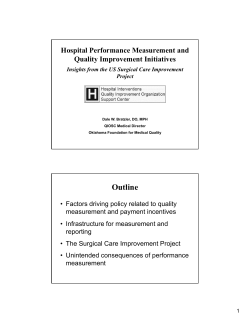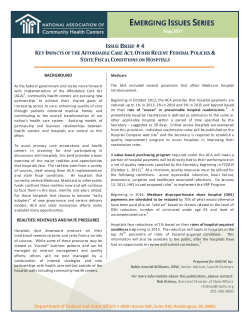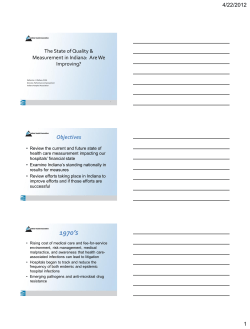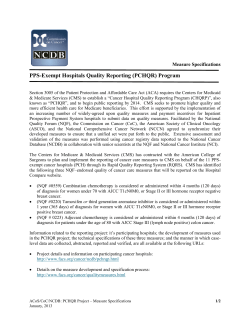
Valma Harjutsalo, PhD Reijo Sund, PhD Mikael Knip, MD, PhD
Letters Figure. Trend in the Incidence Rate of Type 1 Diabetes With 2 Joinpoints in Children Younger Than 15 Years in Finland Between 1980 and 2011 Incidence Rate of Type 1 Diabetes per 100 000 Person-Years 70 60 Author Affiliations: National Institute for Health and Welfare, Diabetes Prevention Unit, Helsinki, Finland (Harjutsalo); National Institute for Health and Welfare, Service Systems Research Unit, Helsinki, Finland (Sund); Children’s Hospital, University of Helsinki, Helsinki, Finland (Knip); Folkhälsan Institute of Genetics, Biomedicum Helsinki, Helsinki, Finland (Groop). 50 40 30 Observed incidence APC 1 = 0.43 APC 2 = 3.60a APC 3 = –0.62 20 10 0 1978 1982 1986 1990 1994 1998 2002 2006 2010 Time of Diagnosis, y APC indicates annual percentage change and it shows trend in incidence over time. a Indicates that the trend is statistically significant. 60.6 (95% CI, 57.1-64.3) per 100 000 person-years for 10-14 years. Joinpoint regression highlighted 2 significant changes in the longer-term trend (Figure). After a modest increase until 1988, the incidence increased annually by 3.6% (95% CI, 2.9%-4.3%; P<.001) until 2005, followed by a plateau until the end of 2011. Discussion | The encouraging observation in this study is that the incidence of T1D in Finnish children younger than 15 years has ceased to increase after a period of accelerated increase. This may be due to changes in the environment,3 such as vitamin D intake. The amount of vitamin D recommended for supplementation in infants had been reduced to one-tenth since the 1950s, during which time the incidence of T1D increased 5-fold. The fortification of dairy products with vitamin D after 2003 may have contributed to the leveling off of T1D incidence.3 The increased prevalence of overweight and obesity also has been suggested to contribute to the increasing incidence of T1D. Overweight and obesity in children have increased in Finland during the past 2 decades; however, there is no evidence of a decrease in this risk factor since 2005.4 Enteroviruses are possibly involved in the pathogenesis of T1D. The number of severe enterovirus infections in Finland increased 10-fold from 2006 to 2010 and it is likely that milder infections increased as well5; however, the incidence of T1D did not increase during the same period. The main limitation of this study is that we were not able to compare the changes in temporal incidence in children with older age groups. Therefore, we cannot determine whether the clinical manifestation is only shifted to older ages. The results should be interpreted with caution because it is possible that this is only a temporary phenomenon. Longer follow-up and studies that extend the coverage to older ages are warranted. Studies are also needed in other countries because the observations from Finland may not be generalizable. However, Sweden has also reported a similar plateau in incidence during 2005-2007.6 428 Valma Harjutsalo, PhD Reijo Sund, PhD Mikael Knip, MD, PhD Per-Henrik Groop, MD, DMSc Corresponding Author: Valma Harjutsalo, PhD, Folkhälsan Institute of Genetics, Haartmaninkatu 8, PO Box 63, FIN-00014 Helsinki, Finland (valma .harjutsalo@helsinki.fi). Author Contributions: Drs Harjutsalo and Sund had full access to all the data in the study and take responsibility for the integrity of the data and the accuracy of the data analysis. Study concept and design: Harjutsalo, Sund, Knip, Groop. Acquisition of data: Harjutsalo, Sund, Knip. Analysis and interpretation of data: Harjutsalo, Sund, Knip, Groop. Drafting of the manuscript: Harjutsalo, Groop. Critical revision of the manuscript for important intellectual content: Harjutsalo, Sund, Knip, Groop. Statistical analysis: Harjutsalo, Sund. Obtained funding: Groop. Administrative, technical, or material support: Sund. Study supervision: Knip, Groop. Conflict of Interest Disclosures: The authors have completed and submitted the ICMJE Form for Disclosure of Potential Conflicts of Interest. Dr Knip reported receiving lecture honoraria from Novo Nordisk; serving on the board for Vactech Ltd, a small biotech company developing vaccines against picornaviruses; and being a minor (<5%) shareholder of Vactech. Dr Groop reported receiving lecture honoraria from Boehringer Ingelheim, Genzyme, Novartis, Novo Nordisk, Merck Sharp Dohme Finland, Eli Lilly, and Medscape; serving on an advisory board for Boehringer Ingelheim, Novartis, and Medscape; receiving investigator-initiated study grants from Eli Lilly and Roche; institutional grants from the Folkhälsan Research Foundation and the Wilhelm and Else Stockmann Foundation; and receiving payment for the development of educational presentations from Medscape. No other disclosures were reported. Funding/Support: This research was supported by grants from the Folkhälsan Research Foundation, the Wilhelm and Else Stockmann Foundation, the Academy of Finland (134379), and the Liv och Hälsa Foundation. Role of the Sponsor: The sponsors had no role in the design and conduct of the study; collection, management, analysis, and interpretation of the data; and preparation, review, or approval of the manuscript; and decision to submit the manuscript for publication. 1. Forlenza GP, Rewers M. The epidemic of type 1 diabetes: what is it telling us? Curr Opin Endocrinol Diabetes Obes. 2011;18(4):248-251. 2. Harjutsalo V, Sjöberg L, Tuomilehto J. Time trends in the incidence of type 1 diabetes in Finnish children: a cohort study. Lancet. 2008;371(9626):1777-1782. 3. Knip M, Simell O. Environmental triggers of type 1 diabetes. Cold Spring Harb Perspect Med. 2012;2(7):a007690. 4. Kaikkonen R, Mäki P, Hakulinen-Viitanen T, et al, eds. Health and Well-being Inequalities Among Children and Their Families [in Finnish]. Helsinki, Finland: National Institute for Health and Welfare; 2012. 5. Hulkko T, Lyytikäinen O, Jaakola S, Kuusi M, Puumala J, Ruutu P, eds. Infectious Diseases in Finland [in Finnish]. Helsinki, Finland: National Institute for Health and Welfare; 2010. 6. Berhan Y, Waernbaum I, Lind T, Möllsten A, Dahlquist G; Swedish Childhood Diabetes Study Group. Thirty years of prospective nationwide incidence of childhood type 1 diabetes: the accelerating increase by time tends to level off in Sweden. Diabetes. 2011;60(2):577-581. COMMENT & RESPONSE Mortality Trends in Critical Access Hospitals To the Editor Dr Joynt and colleagues1 compared mortality trends in critical access hospitals (CAHs) and non-CAHs. Their analysis raises a number of concerns in addition to those raised by JAMA July 24/31, 2013 Volume 310, Number 4 Downloaded From: http://jama.jamanetwork.com/ by a University of Minnesota Twin Cities User on 08/20/2013 jama.com Letters Dr Ioannidis.2 These concerns include problems with the study’s data, methods, and interpretation of the results. The hospital size categories in the study are inappropriate for CAHs, and a number of hospitals were misclassified based on the date of conversion and bed size. In 2002-2003, federal law limited CAHs to 15 beds; since 2004, the limit is 25 beds. However, Joynt et al1 reported that 40 CAHs in 2002 and 63 CAHs in 2010 had between 100 and 399 beds. Thus, a minimum of 5% of CAHs in the analysis were misclassified as being much larger than they were. Inaccurate measurement of bed size may conflate CAH status with hospital scale, effectively comparing CAHs with larger (and distinctly different) non-CAHs, and leading to an overestimate of the excess mortality associated with CAH status. Because very few non-CAH rural hospitals had fewer than 25 beds in 2010, the assumptions required for matching estimation may have been violated. The 2-step estimation process ignores estimation error in the severity adjustment process and systematically underestimates standard errors in the second stage. Consequently, we cannot be confident that the identified differences were significant. This study focused only on inpatients, but CAHs often stabilize and transfer patients from the emergency department (ED); regional systems of care in several states facilitate timely transfer of patients with ST-segment elevation myocardial infarction.3 Other rural patients may make an informed decision to remain in a small hospital close to home rather than being transferred to the high-tech environment of a tertiary facility. Adherence to the principles of patient-centered care means that those choices need to be respected. The authors speculated that lack of a quality reporting mandate could be a reason for higher CAH mortality rates; however, the majority of CAHs voluntarily participate in quality reporting and improvement activities.4 They also hypothesized that CAH mortality rates were higher because “… cost-based reimbursement may remove incentives to pursue efficiency …,” based on research that found CAHs are less cost-efficient.5 In fact, Rosko and Mutter5 also found that lower heart failure mortality rates in CAHs are associated with higher costs and suggest this may reflect the resources that hospitals need to invest to improve patient outcomes. Researchers who analyze rural health policy issues need to understand the rural health care environment. If not, their research has the potential to harm rather than help rural hospitals and health care professionals in providing high-quality care for their patients. Ira S. Moscovice, PhD Michelle M. Casey, MS Jeffrey S. McCullough, PhD Author Affiliations: Rural Health Research Center, University of Minnesota, Minneapolis (Moscovice, Casey, McCullough). Corresponding Author: Ira S. Moscovice, PhD, University of Minnesota Rural Health Research Center, 420 Delaware St SE, MMC 729, Minneapolis, MN 55455 (mosco001@umn.edu). Conflict of Interest Disclosures: The authors have completed and submitted the ICMJE Form for Disclosure of Potential Conflicts of Interest and all 3 reported receiving grants from the Federal Office of Rural Health Policy. Dr Moscovice and Ms Casey also reported receiving travel expenses from the Federal Office of Rural Health Policy. 1. Joynt KE, Orav EJ, Jha AK. Mortality rates for Medicare beneficiaries admitted to critical access and non-critical access hospitals, 2002-2010. JAMA. 2013;309(13):1379-1387. 2. Ioannidis JPA. Are mortality differences detected by administrative data reliable and actionable? JAMA. 2013;309(13):1410-1411. 3. Gale J. Flex Monitoring Team Briefing Paper No. 29: developing regional STEMI systems of care: a review of the evidence and the role of the Flex program, October 2011. http://flexmonitoring.org/documents /STEMI-BriefingPaper29.pdf. Accessed May 30, 2013. 4. Casey M, Moscovice I, Hung P, Barton B. Flex Monitoring Team Briefing Paper No. 31: critical access hospital year 7 hospital compare participation and quality measure report, August 2012. http://www.flexmonitoring.org/documents /Hospital-Compare-Report-Year7.pdf. Accessed May 30, 2013. 5. Rosko MD, Mutter RL. Inefficiency differences between critical access hospitals and prospectively paid rural hospitals. J Health Polit Policy Law. 2010;35(1):95-126. To the Editor Patients living in rural communities require reliable data to make decisions about where to seek care when faced with a serious illness. Unfortunately, Dr Joynt and colleagues1 made a significant error in their methods by not accounting for the large and growing number of patients who present to an ED at a CAH, receive high-quality care, and are transferred to an urban tertiary care hospital directly from the ED. In fact, developing strong partnerships with urban hospitals is a prerequisite for acquiring and maintaining CAH status. We are not surprised by the decrease in interhospital transfers reported by the authors because CAHs are likely making improvements in ED triage. For example, 20% to 25% of patients with an acute myocardial infarction (AMI) are transferred directly from the ED to a hospital with more specialized acute services.2 Transfer rates from the ED have been increasing over time,3 which may be an example of important CAH quality improvement. Patients transferred from the EDs of community hospitals, including CAHs, are younger, have fewer comorbid conditions, and have better clinical outcomes.4 Therefore, one would expect the mortality rate of patients hospitalized at CAHs to increase over time because they do not include this younger, healthier group of patients. An analysis of all patients (rather than just Medicare patients) presenting to a CAH will provide important data. A Medicare analysis might use zip code or ED billing data to better define the full episode of care received at a CAH. The adjustment for number of hospital beds seems too broad. Pairing a CAH of 15 to 25 beds with a non-CAH of 90 beds will not provide an equivalent matched pair and may result in spurious results. In Table 4 in the article, 794 CAHs provided care to 38 375 Medicare patients with AMI (48 patients with AMI per CAH) compared with 161 AMI patients per non-CAH (435 hospitals/70 383 patients with AMI). This is really a comparison of smaller vs larger hospitals, not CAH vs non-CAH. We believe the authors’ findings suggest that their list of interventions to improve care and appropriate transfer may have already been implemented, leading to improved overall care at CAHs. By separating out patients hospitalized in a CAH, they fail to provide a complete analysis of the care provided by a CAH that also includes ED care and a host of outpatient services, such as imaging, laboratory, home health, and longterm care. jama.com Downloaded From: http://jama.jamanetwork.com/ by a University of Minnesota Twin Cities User on 08/20/2013 JAMA July 24/31, 2013 Volume 310, Number 4 429 Letters John M. Westfall, MD, MPH Marc Ringel, MD John Gardner, MHA Author Affiliations: Colorado Healthop, Denver (Westfall); Retired from Brush Family Medicine, Brush, Colorado (Ringel); Yuma District Hospital, Yuma, Colorado (Gardner). Corresponding Author: John M. Westfall, MD, MPH, University of Colorado, 13120 E 19th Ave, Room 5236, Aurora, CO 80111 (jack.westfalj@gmail.com). Conflict of Interest Disclosures: The authors have completed and submitted the ICMJE Form for Disclosure of Potential Conflicts of Interest and none were reported. 1. Joynt KE, Orav EJ, Jha AK. Mortality rates for Medicare beneficiaries admitted to critical access and non-critical access hospitals, 2002-2010. JAMA. 2013;309(13):1379-1387. 2. Westfall JM, Van Vorst RF, McGloin J, Selker HP. Triage and diagnosis of chest pain in rural hospitals: implementation of the ACI-TIPI in the High Plains Research Network. Ann Fam Med. 2006;4(2):153-158. 3. Westfall JM, McGloin J. Impact of double counting and transfer bias on estimated rates and outcomes of acute myocardial infarction. Med Care. 2001;39(5):459-468. 4. Mehta RH, Stalhandske EJ, McCargar PA, Ruane TJ, Eagle KA. Elderly patients at highest risk with acute myocardial infarction are more frequently transferred from community hospitals to tertiary centers: reality or myth? Am Heart J. 1999;138(4 pt 1):688-695. In Reply Dr Moscovice and colleagues and Dr Westfall and colleagues make several important points with which we agree. First, regarding misclassification, we suspect that the higher number of beds than anticipated were due to beds that do not count toward the 25-bed limit, such as psychiatric, rehabilitation, observation, and labor and delivery beds. If CAHs are matched against much larger hospitals because of their size classification in the American Heart Association survey, it certainly would have biased our results. However, it was out of this concern that we adjusted for number of beds rather than size category, and unless CAHs were systematically overreporting their beds in a way that is different from non-CAHs, we suspect any bias is likely to be small. The recent work by Casey and Moscovice1 has been consistent with ours, demonstrating that CAHs lag behind nonCAHs in the quality of care provided for patients with AMI, providing further confidence in our findings. However, we agree with Moscovice and colleagues that CAHs are often underresourced2 and in need of additional supports, such as greater use of telemedicine and stronger partnerships with larger centers to optimize quality of care. Such partnerships may help ensure that when patients prefer to remain at CAHs,1 they can continue to receive high-quality care. Westfall and colleagues raise important points about patients who might be transferred from the ED without being admitted. The rate of ED transfer could be potentially important, although we could not find any national data on how often this occurs among CAHs or whether it has changed over time. The number of patients admitted to CAHs for the 3 conditions we studied has increased slightly over time (46 per hospital in 2002 vs 49 per hospital in 2010), whereas in nonCAHs it has decreased by nearly 30%. If CAHs are indeed transferring an increasing proportion of their patients from the ED, one would have to postulate that the number of patients with these conditions in rural areas is increasing dramatically 430 (even though it appears to be decreasing elsewhere). We are unaware of any data to support this notion. In addition, we agree with Westfall and colleagues’ broader point that many CAHs and networks of hospitals are making important changes to improve care. The program for rural hospitals in Colorado3 and similar programs, such as Reperfusion of Acute Myocardial Infarction in North Carolina Emergency Departments,4 have the potential to improve outcomes for rural patients with AMI if they can be implemented more widely. Taken together, our findings and those of others1 suggest that new initiatives are needed to help CAHs provide better care for acutely ill patients. It is not just that these hospitals have worse outcomes, but that the gap between CAHs and nonCAHs is widening over time. Most of the CAH leaders and clinicians with whom we have spoken work tirelessly under very difficult circumstances. Policies need to be crafted to support these individuals for the one goal with which everyone can agree: all patients deserve high-quality health care, no matter where they live. Karen E. Joynt, MD, MPH John E. Orav, PhD Ashish K. Jha, MD, MPH Author Affiliations: Harvard School of Public Health, Boston, Massachusetts (Joynt, Orav, Jha). Corresponding Author: Karen E. Joynt, MD, MPH, Harvard School of Public Health, 677 Huntington Ave, Boston, MA 02115 (kjoynt@hsph.harvard.edu). Conflict of Interest Disclosures: The authors have completed and submitted the ICMJE Form for Disclosure of Potential Conflicts of Interest. Dr Orav reported receiving a grant from the Rx Foundation. Drs Joynt and Jha reported no disclosures. 1. Casey M, Moscovice I. Flex Monitoring Team Briefing Paper No. 28: Critical Access Hospital Year 6 Hospital Compare Participation and Quality Measure Results. Minneapolis, MN: Flex Monitoring Team; 2011. 2. Joynt KE, Harris Y, Orav EJ, Jha AK. Quality of care and patient outcomes in critical access rural hospitals. JAMA. 2011;306(1):45-52. 3. Westfall JM, Van Vorst RF, McGloin J, Selker HP. Triage and diagnosis of chest pain in rural hospitals: implementation of the ACI-TIPI in the High Plains Research Network. Ann Fam Med. 2006;4(2):153-158. 4. Jollis JG, Roettig ML, Aluko AO, et al; Reperfusion of Acute Myocardial Infarction in North Carolina Emergency Departments (RACE) Investigators. Implementation of a statewide system for coronary reperfusion for ST-segment elevation myocardial infarction. JAMA. 2007;298(20):2371-2380. Chelation Therapy and Cardiovascular Outcomes To the Editor The surprising finding that chelation therapy modestly reduces cardiovascular outcomes1 raises 2 important issues: What is the mechanism of benefit and how valid are the results? For further scientific study, the investigators may wish to consider 2 reports2,3 that identified a relationship between cadmium exposure and cardiovascular risk. The findings from the reports may be important because cadmium, a constituent of cigarette smoke, is avidly bound by EDTA.4 Regarding the validity of the results, the investigators were appropriately circumspect in their conclusions and recognized that the statistical bar in a large clinical trial can be quite easily met when the null hypothesis is rejected at a single point in time for a single end point in a group of patients with a high JAMA July 24/31, 2013 Volume 310, Number 4 Downloaded From: http://jama.jamanetwork.com/ by a University of Minnesota Twin Cities User on 08/20/2013 jama.com
© Copyright 2025


